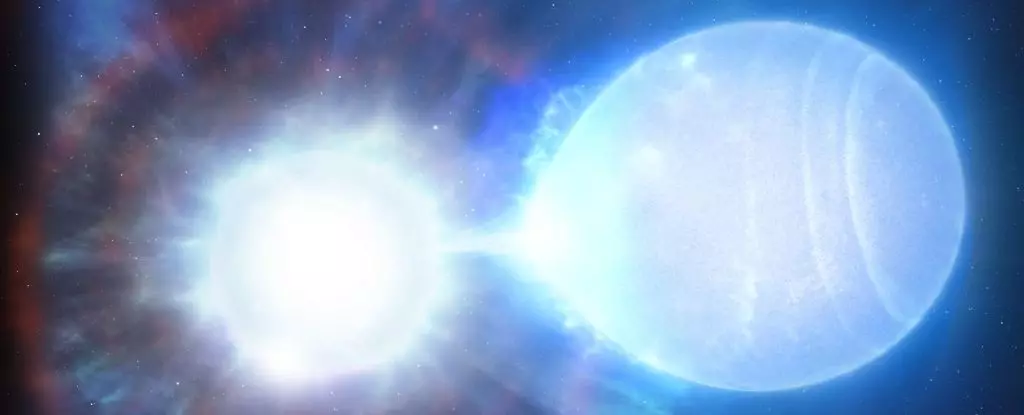In the grand ballet of the cosmos, stars are born, live, and eventually meet their end, often in spectacular fashion. Among the myriad types of celestial bodies, white dwarfs represent a pivotal phase in stellar evolution. These remnants stand as the final beacon of life for stars that were once massive enough to undergo nuclear fusion, yet are no longer fusing new elements. Accordingly, their ultimate fate can shed crucial light on various astronomical phenomena—most notably, Type Ia supernovae—events that not only illuminate the night sky but also serve as fundamental tools for cosmological measurements.
One particularly significant discovery has emerged from the observation of a binary white dwarf system located approximately 150 light-years away. This rare pairing holds within it the enticing potential for a Type Ia supernova, an explosion that could illuminate the very fabric of space-time and offer unprecedented insights into the universe’s expansion. Scientists have posited that this binary system could collide in about 23 billion years, but the real intrigue lies in what the discovery illuminates about the life cycles of stars and the cosmic events that shape our understanding of the universe.
The Twin Stars: A New Dawn in Stellar Research
Astrophysicist James Munday and his research team have brought us compelling evidence that pushes the boundaries of our understanding of white dwarfs and their role in Type Ia supernovae. Their findings challenge long-held views and provide confirmation of a theoretical prediction: that a high proportion of Type Ia supernovae arise from white dwarf pairs, not from single stars. This realization offers an exciting avenue for future research, as the Milky Way is home to a plethora of binary systems whose dynamics and eventual fates may not yet be fully explored.
The binary white dwarf system, designated as WDJ181058.67+311940.94, represents a crucial missing piece in the astronomical puzzle—a tangible example confirming the hypothesis that these systems could be a primary source of Type Ia supernovae. What makes this discovery even more electrifying is the proximity of the system; residing within our galactic neighborhood allows astronomers to study it far more intimately than other distant celestial phenomena.
The Mechanism of Stellar Catastrophe
For a white dwarf to evolve into a Type Ia supernova, it must breach the Chandrasekhar limit—approximately 1.4 times the mass of our Sun. This celestial conundrum unfolds when one white dwarf siphons material from its companion, ultimately leading to a catastrophic collapse. In the case of WDJ181058.67+311940.94, observations indicate that the two stars are separated by a mere fraction of the distance from Earth to the Sun, fostering a scenario ripe for such catastrophic interaction.
As the stars gravitate toward one another, their mutual gravitational pull draws them closer, setting the stage for an inevitable merger. Scientists project that over an extended period, this binary pair will gradually lose energy, spiraling inwards until the moment of cataclysmic change arrives. While this event is eons away—over 23 billion years—the implications for our understanding of stellar life cycles are immediate and profound.
Type Ia Supernovae: More than Just Cosmic Fireworks
Type Ia supernovae are remarkable for their ability to serve as “standard candles” in the cosmos. Because they explode with a consistent peak brightness, they become key markers for astronomers seeking to measure vast distances throughout the universe. Notably, these explosions also contribute essential heavy elements back into the interstellar medium—elements formed during the star’s life—and are central to the fabric of the cosmic ecosystem.
The new evidence for the origins of these explosives, primarily sourced in binary systems, enriches our understanding of both the composition of the universe and its expansion. The potential to account for a significant fraction of the known Type Ia supernovae linked to white dwarf binaries transforms how astrophysicists can model the cosmic expansion and the development of galactic structures.
The Future of Stellar Exploration
With the confirmation of the WDJ181058.67+311940.94 system as a Type Ia progenitor, the pathway is clear for astronomers to deepen and enhance their exploration of binary systems throughout the Milky Way. The tantalizing possibility that many similar systems exist nearby allows scientists to refine their methods of identification and observation. The cosmos is rich with secrets; unveiling these will require not only curiosity but also advanced techniques, likely available through upcoming telescopes and observatories.
This recent discovery illuminates the path ahead, encouraging astrophysicists and amateur astronomers alike to widen their gaze and seek out these enigmatic double white dwarfs hiding in plain sight. The promises these stellar systems hold for enhancing our comprehension of cosmic explosions remain boundless, pushing the limits of current astronomical paradigms and inviting bold new explorations of the celestial theater above us.
In essence, every binary system is an intriguing narrative waiting to unfold, a glimpse into the transformative processes that govern our universe, and a harbor for discovery. Though we may be but fleeting observers within this cosmic symphony, the stories of stars and their inevitable ends resonate throughout time and space, reminding us of the wondrous universe in which we exist.


Leave a Reply